Menu
The New Contemporary Art Magazine
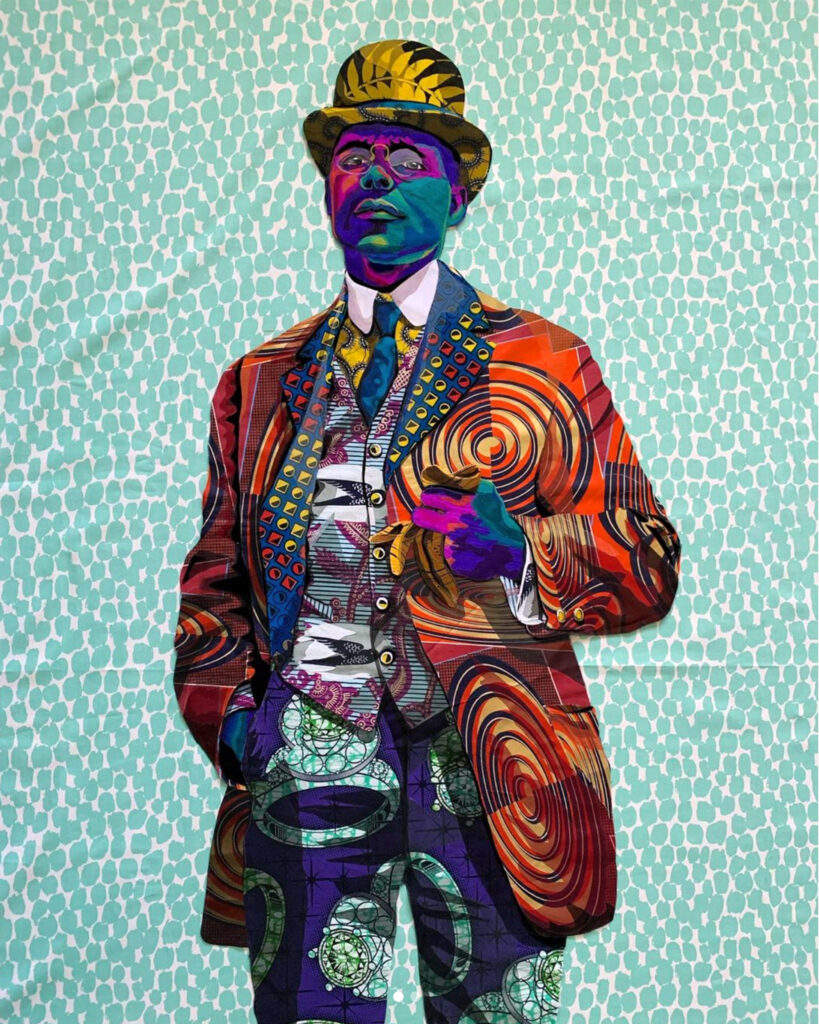
Bisa Butler offers new narrative quilts with two exhibits this spring, at Claire Oliver Gallery and her first solo museum effort at The Katonah Museum of Art. The fiber artist creates startling portraits and scenes with fabric, with her work often being mistaken for paintings. An extended feature on her work appears in Hi-Fructose Vol. 54. Her gallery show runs Feb. 29 through April 18, and her museum show runs March 15 through June 14.
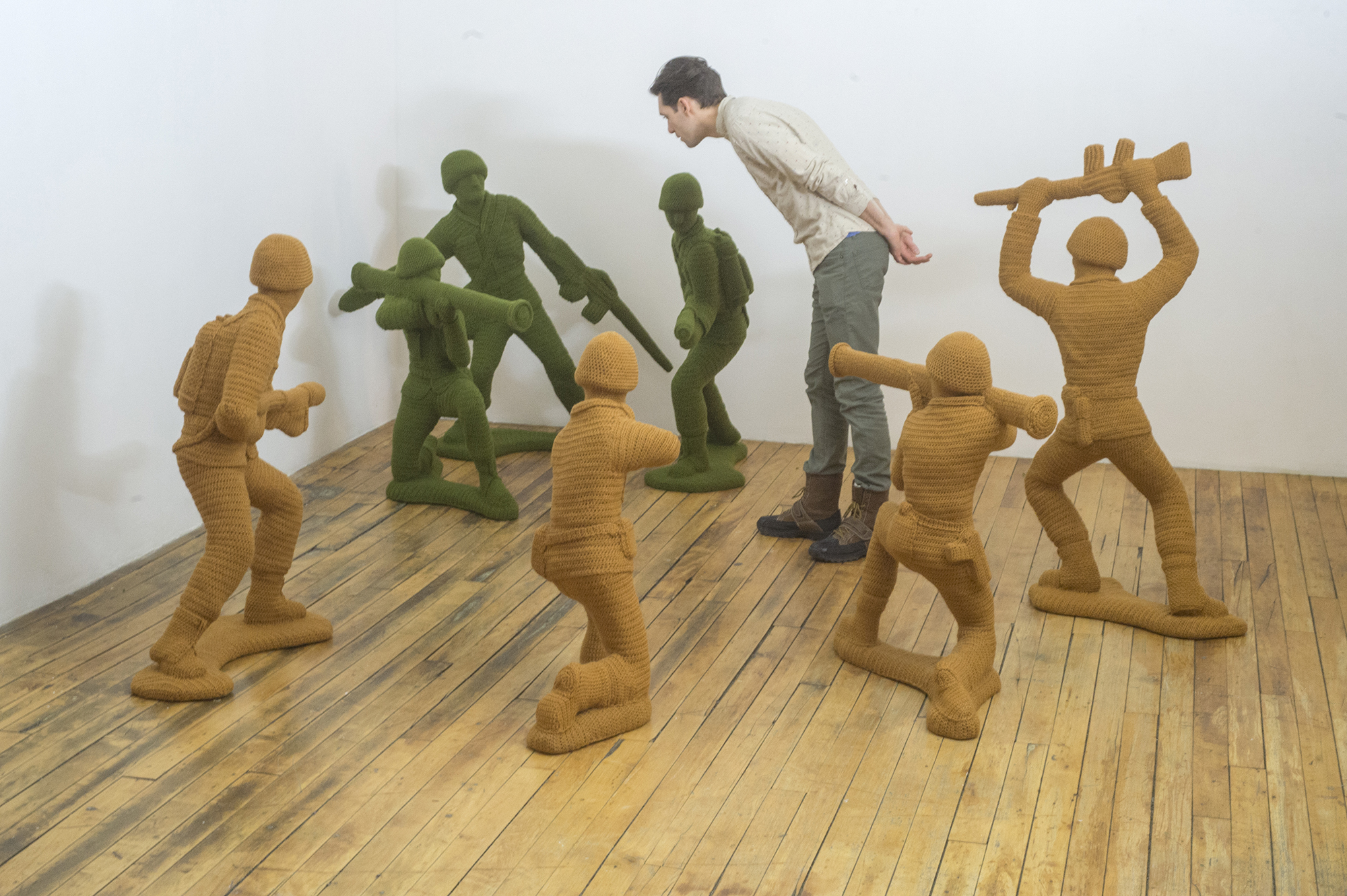 Nathan Vincent's crocheted Army men and weaponry examine the toys and iconography we're handed as children. The artist's work ranges from handheld weaponry to full-room installations like "Locker Room." Each takes a look at sexuality and gender along all stages of life.
Nathan Vincent's crocheted Army men and weaponry examine the toys and iconography we're handed as children. The artist's work ranges from handheld weaponry to full-room installations like "Locker Room." Each takes a look at sexuality and gender along all stages of life.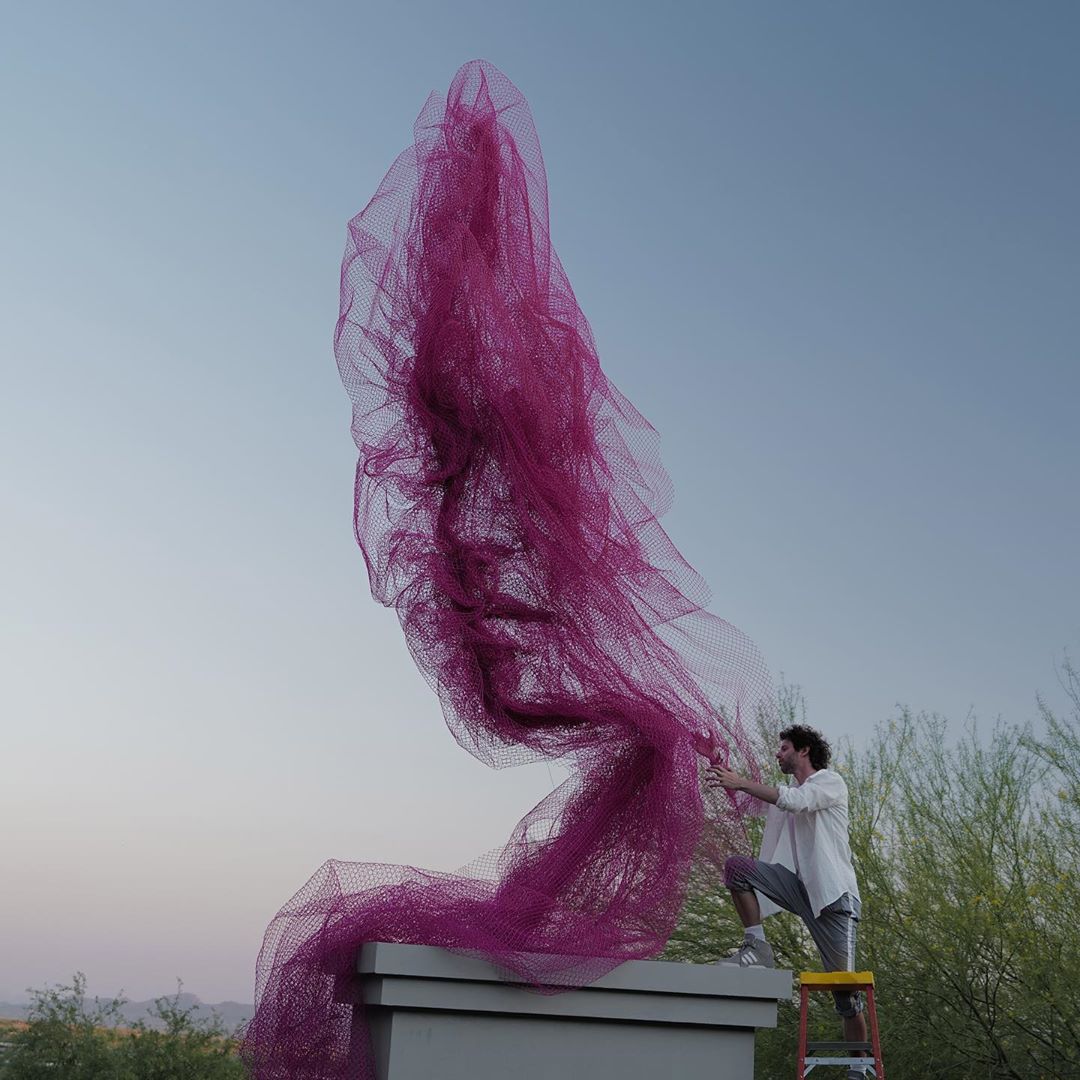 In his “Flow” series, Benjamin Shine shapes netting into captivating and serene portraits. The artist, inspired by the concept of mindfulness, has taken this approach to multiple scales. His recent, outdoor "Sky Flow" sculpture "Quietude" represents a shift forward for the artist, influenced by the smaller works before it on canvas. ("Quietude" photos by Mindbodygreen.)
In his “Flow” series, Benjamin Shine shapes netting into captivating and serene portraits. The artist, inspired by the concept of mindfulness, has taken this approach to multiple scales. His recent, outdoor "Sky Flow" sculpture "Quietude" represents a shift forward for the artist, influenced by the smaller works before it on canvas. ("Quietude" photos by Mindbodygreen.) Working with fabric dye on cotton, Iranian artist Orkideh Torabi creates scenes and portraits that poke fun at the men behind patriarchal societies. The works are tethered to the history of her home country, taking influence from antique Persian miniatures. The artist is currently based in Chicago.
Working with fabric dye on cotton, Iranian artist Orkideh Torabi creates scenes and portraits that poke fun at the men behind patriarchal societies. The works are tethered to the history of her home country, taking influence from antique Persian miniatures. The artist is currently based in Chicago. Sandra de Groot crafts soft armor and ornate headpieces in her macramé “kNOTs” series. When the works adorn models, they are activated in a way that appears both regal and fantastical. Each piece feels independent of any one place or time.
Sandra de Groot crafts soft armor and ornate headpieces in her macramé “kNOTs” series. When the works adorn models, they are activated in a way that appears both regal and fantastical. Each piece feels independent of any one place or time.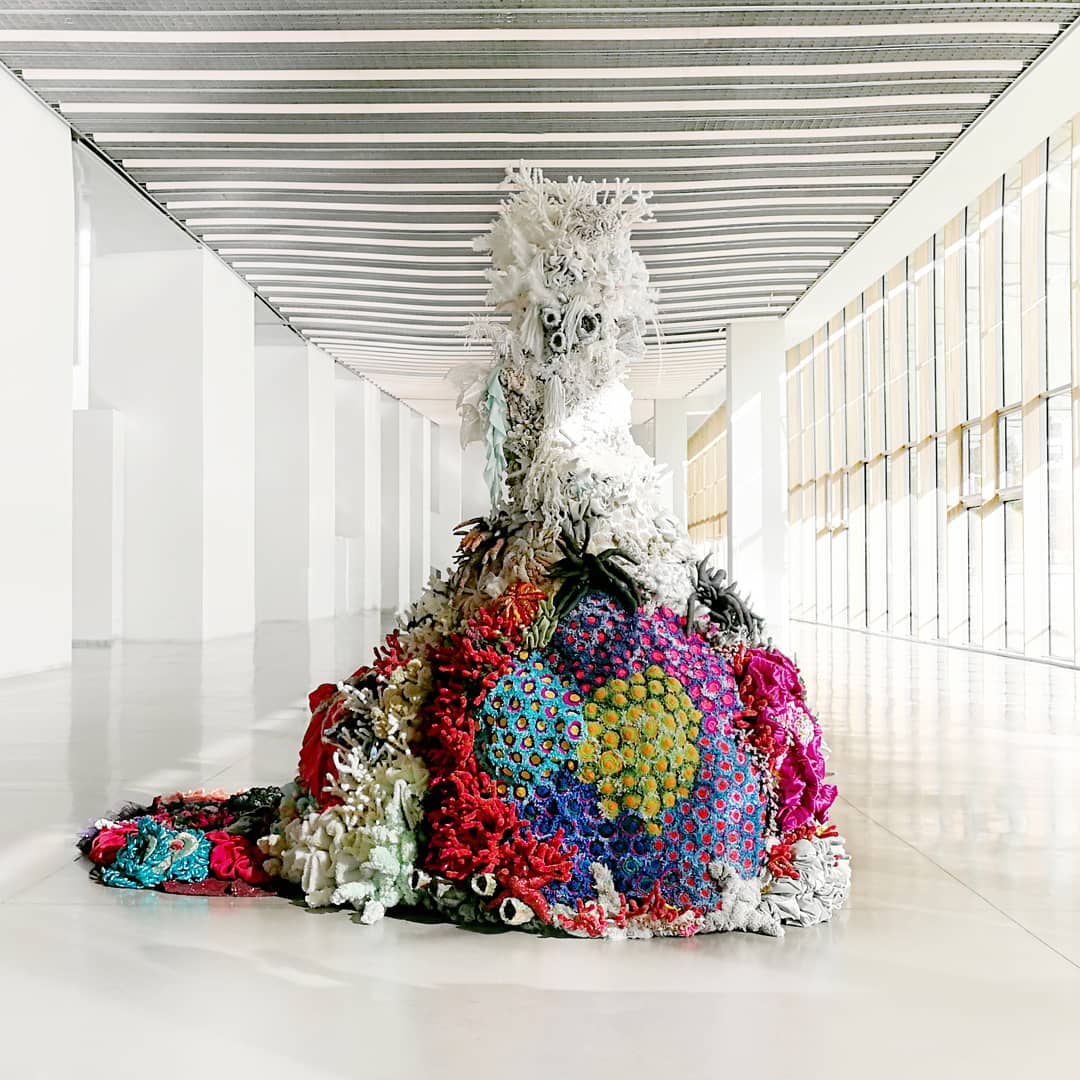 Paola Idrontino's massive textile sculpture “Evanescent” depicts the scourge of coral bleaching in the world’s oceans, brought on by climate change. The work, which took years to complete, was recently on display at Museu del Disseny de Barcelona. Idrontino's practice includes textiles, wearable art, and photography.
Paola Idrontino's massive textile sculpture “Evanescent” depicts the scourge of coral bleaching in the world’s oceans, brought on by climate change. The work, which took years to complete, was recently on display at Museu del Disseny de Barcelona. Idrontino's practice includes textiles, wearable art, and photography.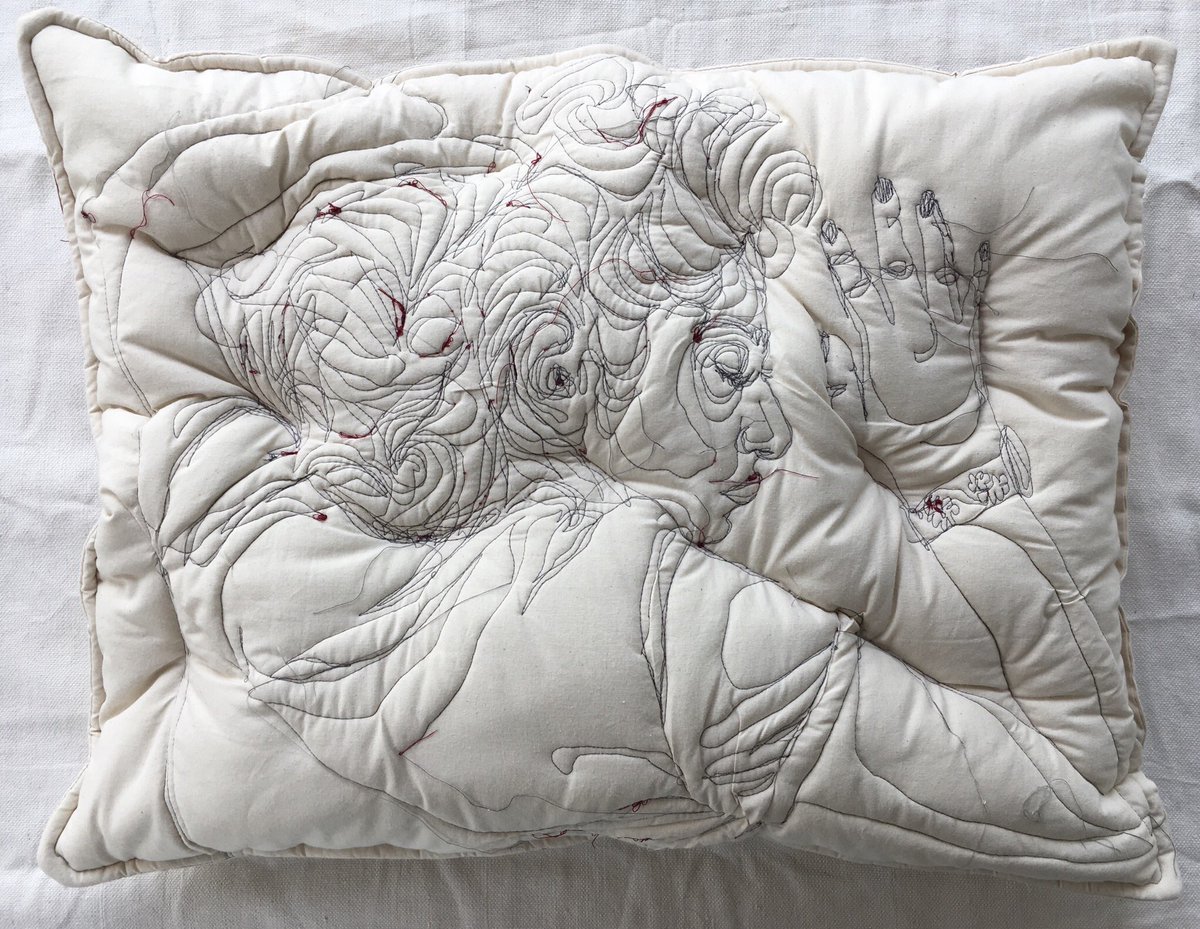 Maryam Ashkanian’s stirring “Sleep” series offers embroidered figures on pillows, with threads creating a sculptural landscape on each canvas. The works carry both an intimacy and are part of a broader practice that implements textiles and painting into unexpected forms. The fiber artist is currently based in Iran, where she operates her studio.
Maryam Ashkanian’s stirring “Sleep” series offers embroidered figures on pillows, with threads creating a sculptural landscape on each canvas. The works carry both an intimacy and are part of a broader practice that implements textiles and painting into unexpected forms. The fiber artist is currently based in Iran, where she operates her studio.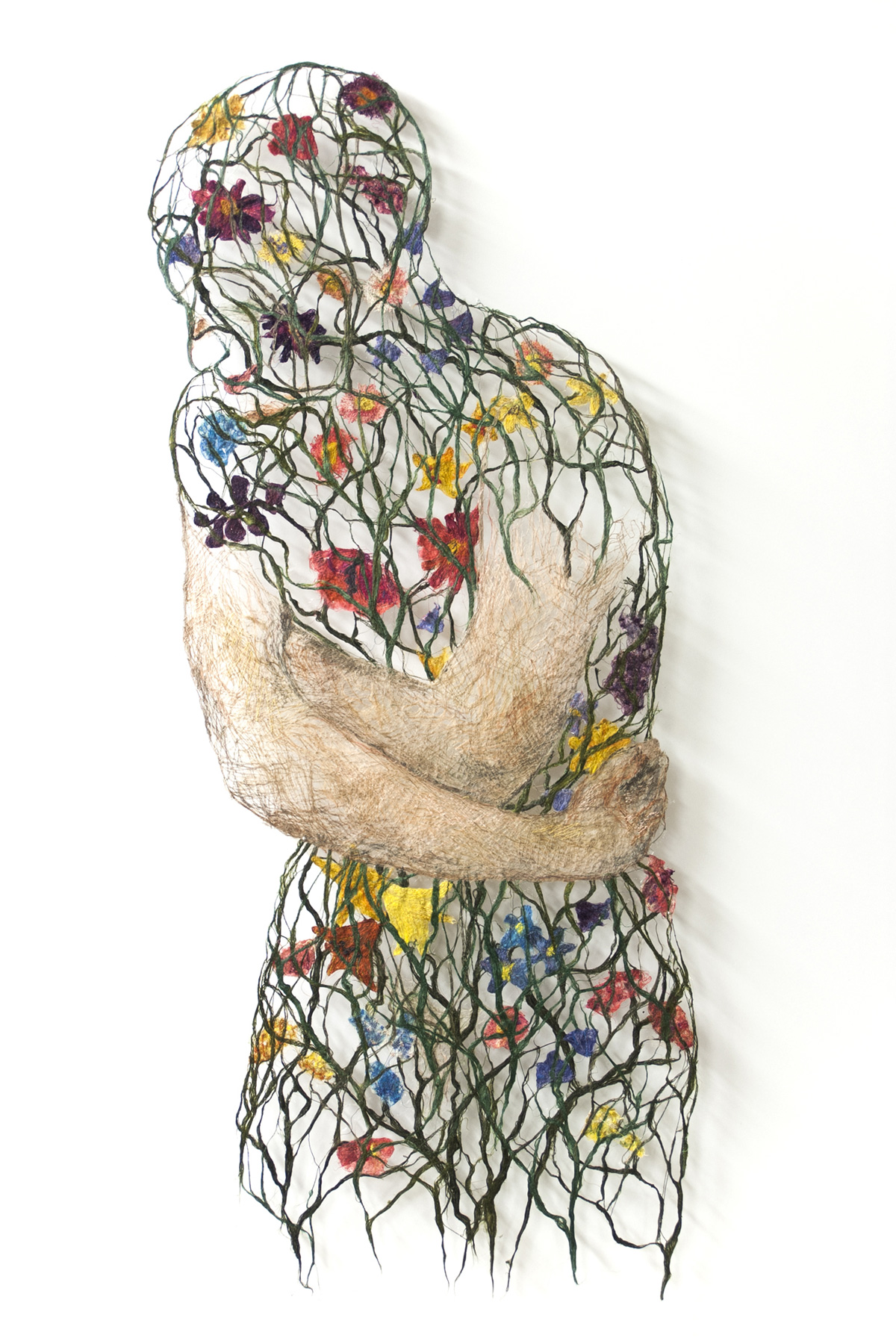 Raija Jokinen reassembles aspects of the human bodies with flax. The Finnish artist interweaves creatures and notes of nature into her recreations of our interior. Jokinen considers her work to exist at the "meeting point of the techniques in painting, graphic art, hand made paper and textile."
Raija Jokinen reassembles aspects of the human bodies with flax. The Finnish artist interweaves creatures and notes of nature into her recreations of our interior. Jokinen considers her work to exist at the "meeting point of the techniques in painting, graphic art, hand made paper and textile."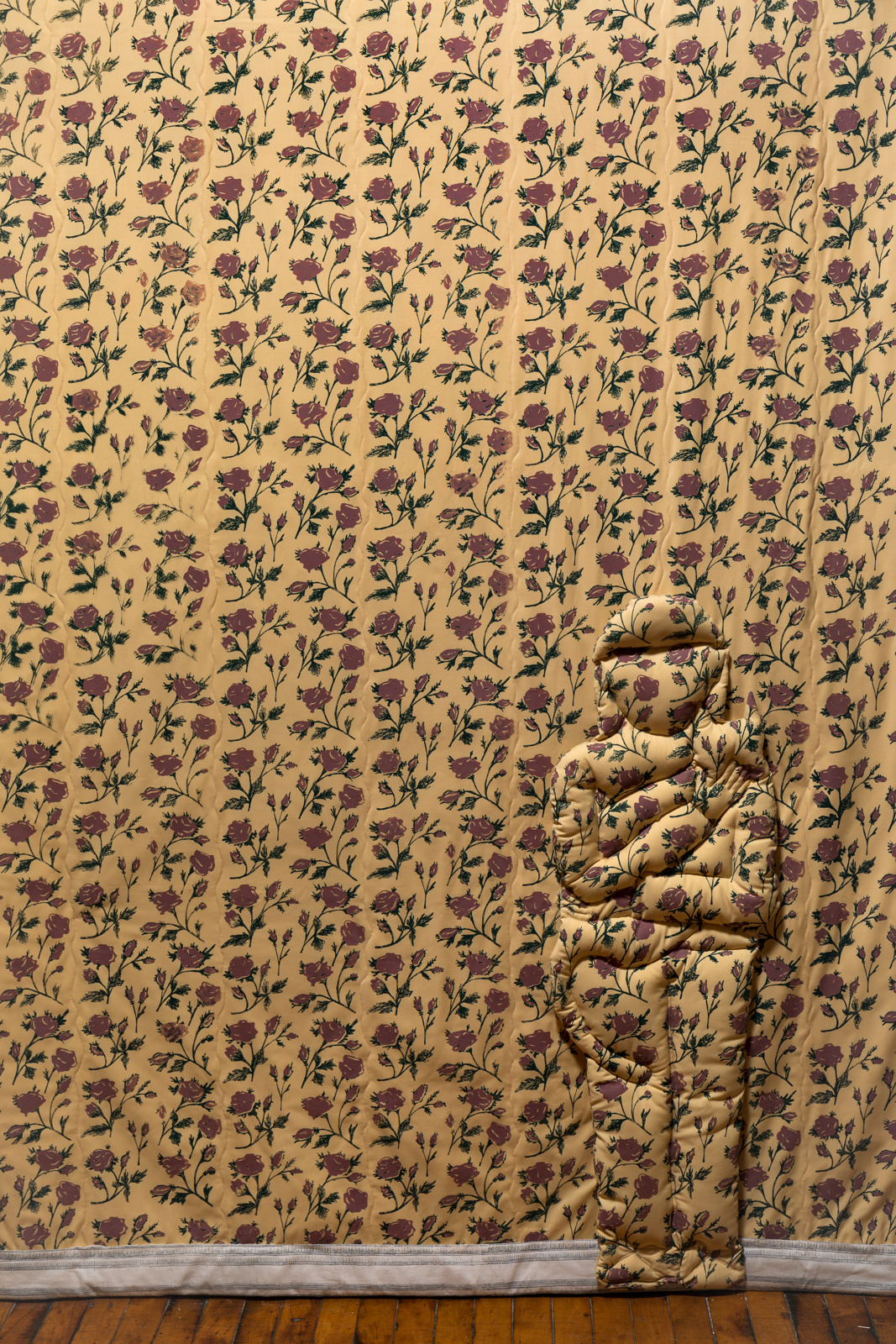 Kay Healy fabric works are based on real stories and memories, with surreal self-portraits and scenes. At times, the artist conveys figures integrated into the textiles. Elsewhere, the work is realistic from a distance, its texture and true nature revealed upon inspection.
Kay Healy fabric works are based on real stories and memories, with surreal self-portraits and scenes. At times, the artist conveys figures integrated into the textiles. Elsewhere, the work is realistic from a distance, its texture and true nature revealed upon inspection.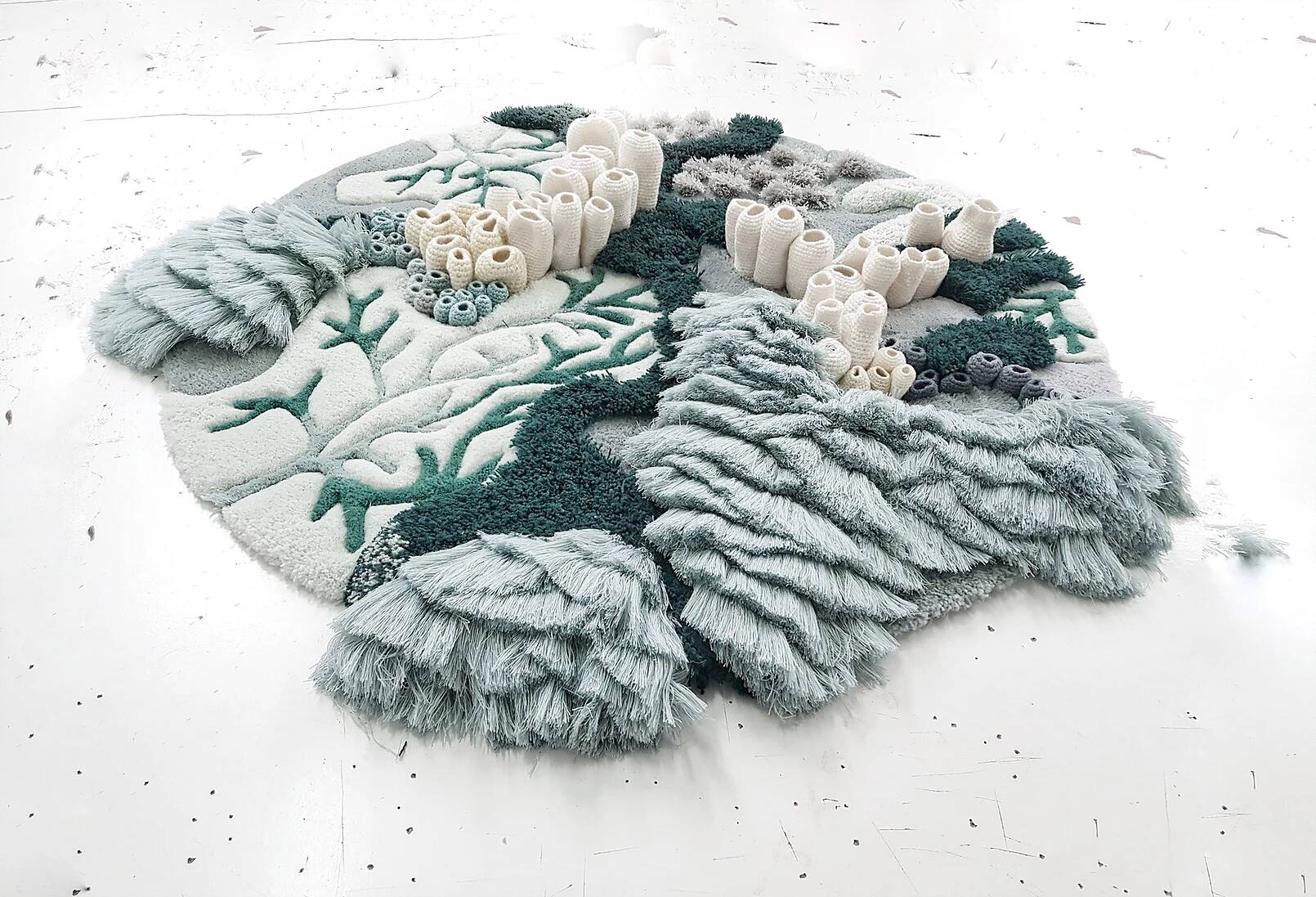 Vanessa Barragão’s textile art emulates the forms and ecosystems of the ocean. In contrast to the ceramic works of artists like Courtney Mattison, who also explore life in the water, the artist’s material adds a different, flowing texture to these scenes. The yarns are upcycled and the techniques artisanal, as the artist acknowledges the polluting affects of the textile industry.
Vanessa Barragão’s textile art emulates the forms and ecosystems of the ocean. In contrast to the ceramic works of artists like Courtney Mattison, who also explore life in the water, the artist’s material adds a different, flowing texture to these scenes. The yarns are upcycled and the techniques artisanal, as the artist acknowledges the polluting affects of the textile industry.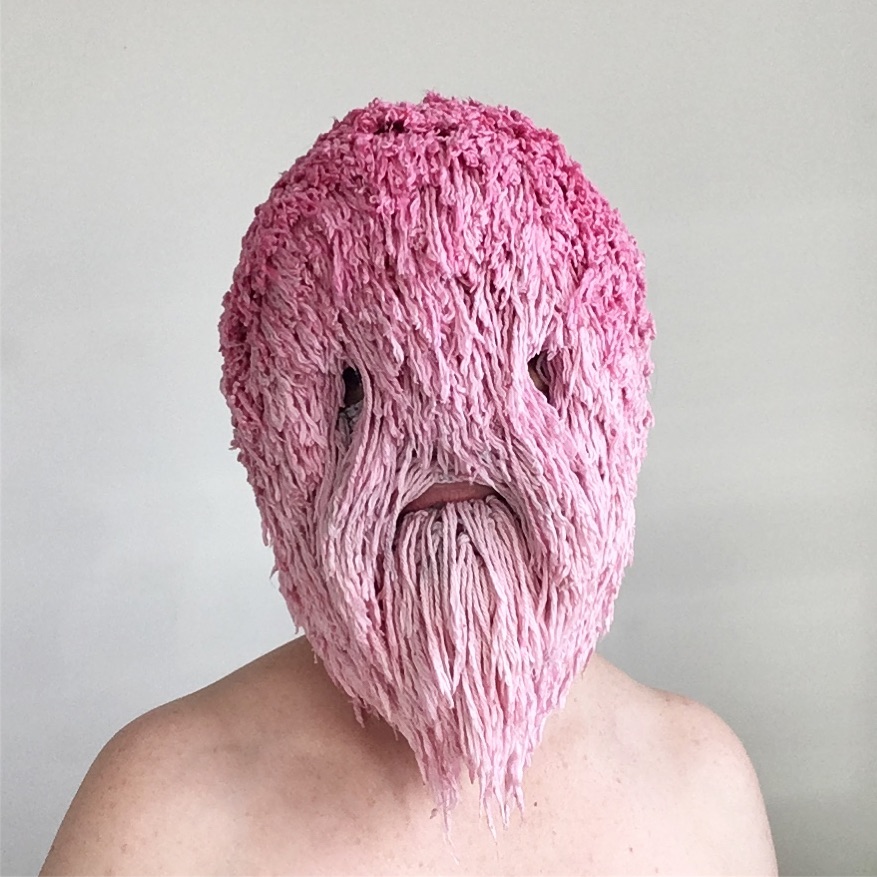 Threadstories is an artist based in Ireland who crafts both engrossing and humorous textile masks. The wearable works take on new characteristics in motion, which she displays on the Threadstories Instagram account.
Threadstories is an artist based in Ireland who crafts both engrossing and humorous textile masks. The wearable works take on new characteristics in motion, which she displays on the Threadstories Instagram account. The strange textile sculptures of Etc. and the Madness subvert humanity in their writhing forms. For some, the creatures may resemble the pop culture-Internet-born villain Slenderman. But Etc.’s characters are decidedly less sinister, and are more disconcerting in how their casual, slumped existences.
The strange textile sculptures of Etc. and the Madness subvert humanity in their writhing forms. For some, the creatures may resemble the pop culture-Internet-born villain Slenderman. But Etc.’s characters are decidedly less sinister, and are more disconcerting in how their casual, slumped existences. Magnhild Kennedy, the Norwegian artist also known as Damselfrau, crafts intricate masks that mix fine art and fashion. She makes these pieces with both textiles and found objects. In a statement, the artist offers her own explanation of this approach:
Magnhild Kennedy, the Norwegian artist also known as Damselfrau, crafts intricate masks that mix fine art and fashion. She makes these pieces with both textiles and found objects. In a statement, the artist offers her own explanation of this approach: Sophia Narrett’s painterly approach to embroidery results in elaborate, startling scenes. Her themes traverse escapism, psychology, and sexuality. Each section of the work brings its own surprising sharpness, with a certain visceral quality resulting from the material.
Sophia Narrett’s painterly approach to embroidery results in elaborate, startling scenes. Her themes traverse escapism, psychology, and sexuality. Each section of the work brings its own surprising sharpness, with a certain visceral quality resulting from the material. The embroidered monsters of Tracy Widdess add an unexpected texture to the horror genre. The Vancouver artist has called her practice "brutal knitting." And with her talents in crafting textile fright, she embodies that label with both wearable and standalone pieces.
The embroidered monsters of Tracy Widdess add an unexpected texture to the horror genre. The Vancouver artist has called her practice "brutal knitting." And with her talents in crafting textile fright, she embodies that label with both wearable and standalone pieces. Jannick Deslauriers uses textiles to create ghostly, massive sculptures. Whether it’s a time-worn car or a cityscape, her works appear as structures that can be passed through. She uses darker threads as her "pencil outlines," blending textures and techniques to create pieces that resemble little else.
Jannick Deslauriers uses textiles to create ghostly, massive sculptures. Whether it’s a time-worn car or a cityscape, her works appear as structures that can be passed through. She uses darker threads as her "pencil outlines," blending textures and techniques to create pieces that resemble little else. Nora Fok’s blend of textile and jewelry art results in otherworldly pieces, implementing a variety of materials and processes for statements that resemble little else in wearable fashion. Despite their progressive, sometimes futuristic look, the pieces often implement age-old approaches: braiding, weaving, and knitting are used to string together hundreds of elements like nylon monofilament and beads.
Nora Fok’s blend of textile and jewelry art results in otherworldly pieces, implementing a variety of materials and processes for statements that resemble little else in wearable fashion. Despite their progressive, sometimes futuristic look, the pieces often implement age-old approaches: braiding, weaving, and knitting are used to string together hundreds of elements like nylon monofilament and beads. Turkish-American designer Eda Yorulmazoğlu crafts wild costumes, with both distinct body of works and individual creatures as part of her repertoire. Part-fashion designer, part-textile artist, she navigates several spheres, all carrying an absurdism and vibrancy bolstered by bringing them out into the public.
Turkish-American designer Eda Yorulmazoğlu crafts wild costumes, with both distinct body of works and individual creatures as part of her repertoire. Part-fashion designer, part-textile artist, she navigates several spheres, all carrying an absurdism and vibrancy bolstered by bringing them out into the public. The textile work of Sabine Feliciano may recall a past biology class for some, as her “dissections” of animals play with the vibrant and textural possibilities of the form. Her “Wild Textile World” takes us inside varying creatures of the natural world. And each takes the traditionally gruesome and adds something new, even lighthearted, to these explorations.
The textile work of Sabine Feliciano may recall a past biology class for some, as her “dissections” of animals play with the vibrant and textural possibilities of the form. Her “Wild Textile World” takes us inside varying creatures of the natural world. And each takes the traditionally gruesome and adds something new, even lighthearted, to these explorations. Nestled beneath the Standard, High Line in New York City’s Meatpacking District, Lucy Sparrow’s all-felt bodega is the first store of its kind. Thousands of products have been created for the space, which duplicates the classic New York bodega with each item a product of the artist's handiwork. This rendition is called “8 ‘Till Late,” following similar projects from the artist, and takes its host city as one of its biggest inspirations.
Nestled beneath the Standard, High Line in New York City’s Meatpacking District, Lucy Sparrow’s all-felt bodega is the first store of its kind. Thousands of products have been created for the space, which duplicates the classic New York bodega with each item a product of the artist's handiwork. This rendition is called “8 ‘Till Late,” following similar projects from the artist, and takes its host city as one of its biggest inspirations. Japan-born, Iowa City-based artist Sayuri Sasaki Hemann creates underwater worlds with fabrics and felt in installations. Projects like “Urban Aquarium,” which started in 2009 and appeared throughout Portland, recreate jellyfish and other sea inhabitants in places them in an airport and other unexpected places.
Japan-born, Iowa City-based artist Sayuri Sasaki Hemann creates underwater worlds with fabrics and felt in installations. Projects like “Urban Aquarium,” which started in 2009 and appeared throughout Portland, recreate jellyfish and other sea inhabitants in places them in an airport and other unexpected places. Burbank, California based artist Michelle Kingdom creates fantastically strange embroideries on linen that look like paintings. Some have even dubbed them as "stitched paintings." For Kingdom, they are "narrative embroideries" that weave stories made out of thread. Embroidery is oftentimes discarded as craft, but that is part of its appeal to the artist, who uses it in an unexpected way to express her innermost thoughts and escape to her imaginary world.
Burbank, California based artist Michelle Kingdom creates fantastically strange embroideries on linen that look like paintings. Some have even dubbed them as "stitched paintings." For Kingdom, they are "narrative embroideries" that weave stories made out of thread. Embroidery is oftentimes discarded as craft, but that is part of its appeal to the artist, who uses it in an unexpected way to express her innermost thoughts and escape to her imaginary world. Boston based sculptor Jenine Shereos often uses fiber and textile processes to create her intricate artworks. Her latest series uses a more unusual material - her own hair. "Leaf Series" portrays the patterned lace-like skeletons of dead leaves with excruciating detail. Shereos discusses her inspiration and process at her website: "Inspired by the delicate and detailed venation of a leaf, I began stitching individual strands of hair by hand into a water- soluble backing material. At each point where one strand of hair intersected another, I stitched a tiny knot, so that when the backing was dissolved, the entire piece was able to hold its form. Creating this work was a very meditative process for me, as I found myself lost in the detail of the small, organic microcosms that began taking shape."
Boston based sculptor Jenine Shereos often uses fiber and textile processes to create her intricate artworks. Her latest series uses a more unusual material - her own hair. "Leaf Series" portrays the patterned lace-like skeletons of dead leaves with excruciating detail. Shereos discusses her inspiration and process at her website: "Inspired by the delicate and detailed venation of a leaf, I began stitching individual strands of hair by hand into a water- soluble backing material. At each point where one strand of hair intersected another, I stitched a tiny knot, so that when the backing was dissolved, the entire piece was able to hold its form. Creating this work was a very meditative process for me, as I found myself lost in the detail of the small, organic microcosms that began taking shape." Originally from Mexico City, Texas-based Gabriel Dawe primarily uses thread as a means of creating fantastical installations. Combining fashion and architecture, his vibrant threaded works (covered here) exhibit a certain strength and delicacy. Dawe's ongoing series of sculptures play with textiles on a much smaller scale. Instead of large spaces, in "End of Childhood", Dawe binds a child's toys such as metal cars and plastic animals like elephants, horses, and dinosaurs.
Originally from Mexico City, Texas-based Gabriel Dawe primarily uses thread as a means of creating fantastical installations. Combining fashion and architecture, his vibrant threaded works (covered here) exhibit a certain strength and delicacy. Dawe's ongoing series of sculptures play with textiles on a much smaller scale. Instead of large spaces, in "End of Childhood", Dawe binds a child's toys such as metal cars and plastic animals like elephants, horses, and dinosaurs. Traditional quilting meets a unconventional use of textile art in San Jose Museum of Quilts & Textiles' upcoming exhibition, "Found/Made." Curated by Roderick Kiracofe, the exhibit brings together quilts of historic and unknown origin with those by contemporary artists, including Ben Venom (covered here), Clay Lohmann, Joe Cunningham, Luke Haynes, Sabrina Gschwandtner, Sarah Nishiura, and Theresa May. Their works match their predecessors' classic techniques, but depart to tell a modern narrative.
Traditional quilting meets a unconventional use of textile art in San Jose Museum of Quilts & Textiles' upcoming exhibition, "Found/Made." Curated by Roderick Kiracofe, the exhibit brings together quilts of historic and unknown origin with those by contemporary artists, including Ben Venom (covered here), Clay Lohmann, Joe Cunningham, Luke Haynes, Sabrina Gschwandtner, Sarah Nishiura, and Theresa May. Their works match their predecessors' classic techniques, but depart to tell a modern narrative.